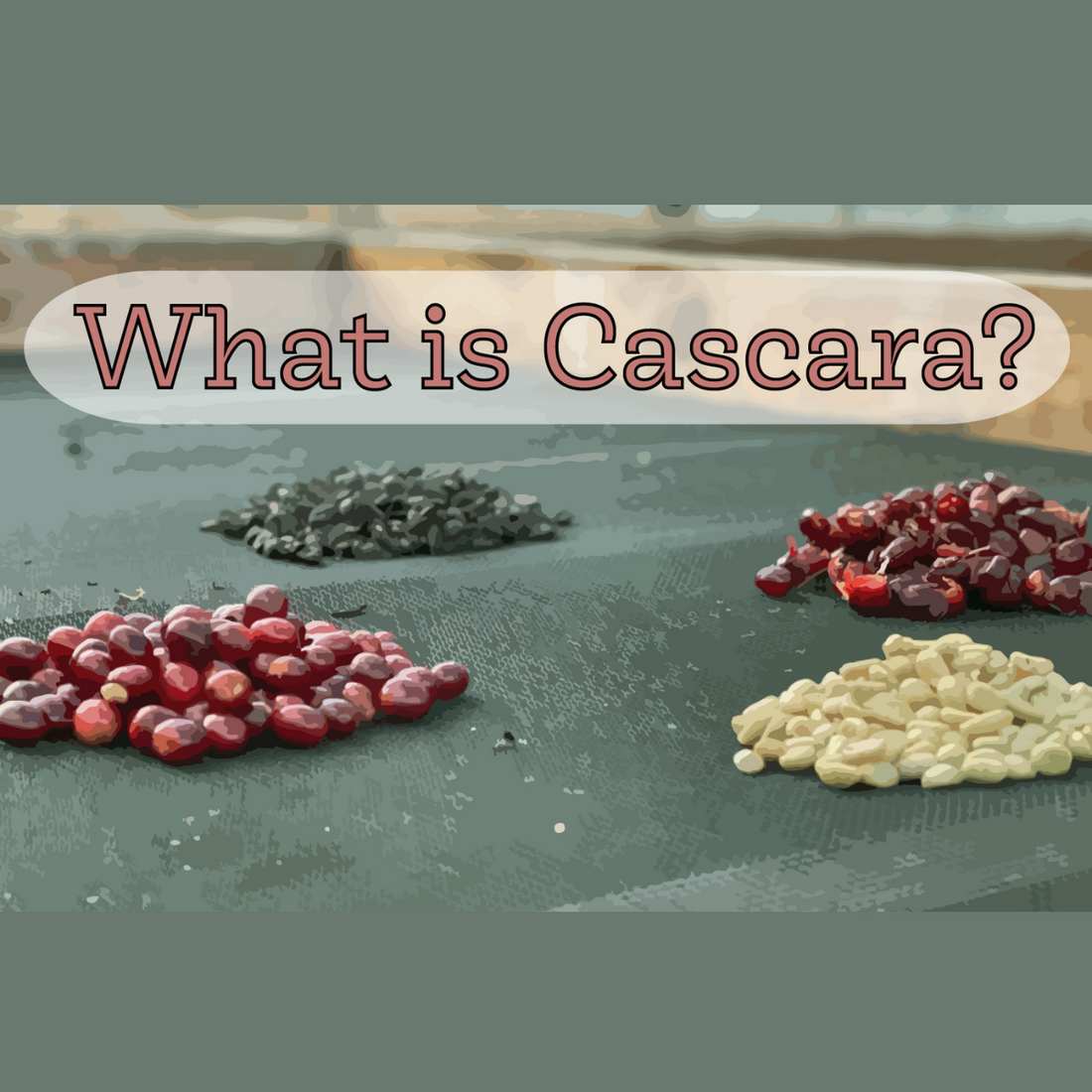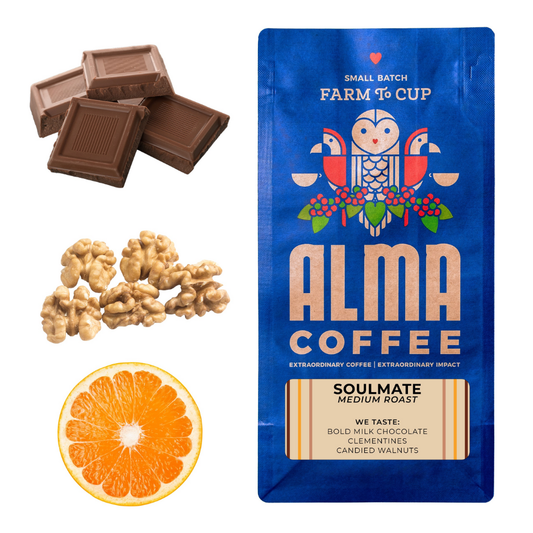
What is Cascara?
Share
The world of coffee has seen a transformation of epic proportions in the last 30 years. While new & exciting brewing methods such as the Chemex and Nitro Cold-Brew have captured the fascination of caffeine lovers worldwide, the search for exciting new ways to enjoy the coffee cherry are often overshadowed.
So, if you are looking for something “new” in the coffee world to sip on during your early morning wake-up routine you might have never heard of before, you might be interested in cascara—also known by many as “coffee cherry tea.”
So, What exactly is "Cascara"? 🤔
To understand exactly what cascara is, you must first understand where it comes from.
One of the biggest misconceptions about coffee in general is that an actual coffee bean—the delicious roasted consumable you end up grinding just before brewing your morning cup—is a bean in the traditional sense (it's not).
Technically speaking, coffee “beans” come from within coffee cherries that grow on coffee trees. When farmers pick ripe coffee cherries from their trees, a long and arduous process of washing, drying, exporting, roasting, and, eventually, brewing & tasting unfolds.
Let's circle back to the “washing” process, better known as coffee processing (which we covered in a full-length blog), as this is where the coffee “beans” are separated from the skins that surround them.
The best analogy we've come across for understanding coffee processing is to think of a coffee cherry like an avocado: there is a seed, skin, and that mushy stuff in between those two things.
In the coffee washing process, depending on the desired goal of the green bean supplier, the skins and mushy insides of coffee cherries are removed to access and dry the underlying seeds. This leaves a byproduct in the process called "cascara," or the outer protective skin of coffee cherries.
"[...] depending on the desired goal of the green bean supplier, the skins and mushy insides of coffee cherries are removed to access and dry the underlying seeds. This leaves a byproduct in the process called "cascara", or the outer protective skin of coffee cherries."
However, unlike an avocado, that coffee cherry skin has some practical use for the coffee consumer. Some coffee farmers might just compost or discard these skins, but others dry them for use in tea, simple syrups, cold brews and even cocktails.
The Alma Coffee family farms, Finca Terrerito, have been drying and using cascara for as long as we can remember! For years we used cascara as organic fertilizer around the farm; But, a few years ago, we learned of the health benefits of drinking cascara and began to process it in our specialty air beds from specific varieties that would yield flavorful teas.
How is Cascara Used? ☕️
Although cascara is really just the outer skin that houses a coffee cherry, its flavor notes couldn’t be further from a cup o’ joe. Cascara is often described as having a sweet, dry and/or fruity taste, which is probably why it is colloquially referred to as “coffee cherry tea” when brewed into its final form.
Historically speaking, cascara has been used just as long (if not longer) than roasted coffee itself. In countries like Yemen and Ethiopia where coffee is known to originate, cascara is actually consumed more frequently than coffee because of its wide accessibility, low production costs, and relatively moderate level of caffeine1. When mixed with natural spices and sugars such as cinnamon or honey, the natural flavor(s) of cascara are really highlighted.
"Although cascara is historically boiled as a hot tea across the world, its uses are fairly ubiquitous and consumers within the coffee trade are starting to take note and get creative."
Although cascara is historically boiled as a hot tea across the world, its uses are fairly ubiquitous and consumers within the coffee trade are starting to take note and get creative. Just quickly browsing around the internet for more ideas on how to activate the natural sweetness of cascara, we found recipes for simple syrups, sparkling sodas, cold brews, cocktails, and even soaps.
Additionally, the health benefits of drinking cascara in its many forms, especially as a hot tea, are plentiful. For starters, cascara has been clinically reported to be a great source of antioxidants2. On top of this, because cascara encases the caffeine-infused coffee seed that eventually becomes roasted coffee, caffeine is naturally activated when cascara is brewed/steeped similarly to tea3. You can enjoy similar levels of caffeine in both coffee and cascara, making it a nice alternative to coffee when you are sick or in the mood for something different.
Here at Alma, our R&D café team has found use for the naturally sweet flavors of dried cascara in our Cascara Mimosa recipe. Simply boil a cup of cascara, a cup of brown sugar, and a cup of water. In a matter of minutes, you’ll have your own cascara simple syrup to add to cocktails or coffees of your choosing!
Check out our video recipe here.
Where can I get my hands on Some Cascara? 👀
So, are you wondering where you can find some sweet, delicious cascara to dry for yourself?
Because cascara is usually produced and sold as a byproduct of coffee, finding quality cascara isn’t as simple as walking into your local grocery store and browsing the roasted coffee aisle. Anyone that has searched for this stuff, either for personal or business use, might already understand the struggles of finding small quantities of the sweet, dried coffee cherry skins.
Luckily for curious cascara consumers everywhere, Alma Coffee owns the farms where our roasted coffee beans—and subsequent cascara cherry skins—are harvested and grown! We sell cascara from our annual coffee harvest while supplies last in both 6 oz and 3 lb quantities!
Have you been reading this wondering what cascara tastes like? We don't blame you!
There are so many possibilities for enjoying the natural fruitiness and sweet flavor notes of cascara in both its historically popular hot tea form and newer, more experimental variants such as simple syrup, cold brew or cocktails!
Order a bag of cascara today and drop a comment below to let us know how you plan on enjoying your cascara!
Sources:
1 “Cascara Tea.” Melbourne Coffee Merchants, melbournecoffeemerchants.com.au/coffee/buena-vista-cascara-tea-organic/.
2 Festa, Jessica. “Discover Coffee Fruit, Nature's Wasted Superfood.” Pastemagazine.com, Paste Magazine, 23 June 2015, www.pastemagazine.com/food/coffee/coffee-fruit-natures-wasted-superfood/.
3 “Cascara Tea.” Melbourne Coffee Merchants, melbournecoffeemerchants.com.au/coffee/buena-vista-cascara-tea-organic/.
Subscribe
Our email newsletter isn't your typical marketing ploy. Sign up now and get our weekly coffee blog posts, YouTube content, and coffee roast announcements!





